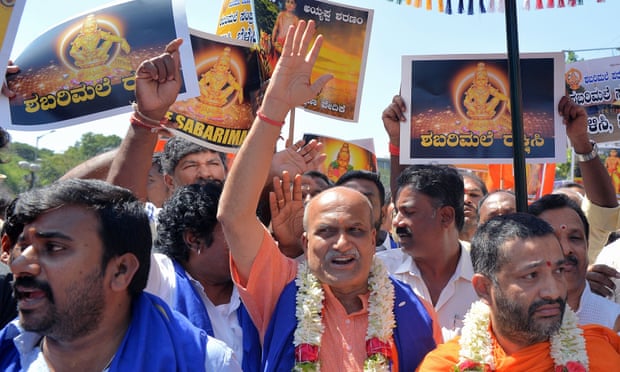- UID
- 20
- Online time
- Hours
- Posts
- Reg time
- 24-8-2017
- Last login
- 1-1-1970
|
Prof Vinita Damodarandraws parallels between recent Sabarimala protests and similar movements against the entry of lower castes into temples in the 1920s.

A rally urging a reversal of a supreme court decision to allow women of ‘menstruating age’ into the Sabarimala temple in Kerala. Photograph: Manjunath Kiran/AFP/Getty Images
▼ The images of large crowds protesting against the entry of women and girls of a certain age into the Sabarimala temple in Kerala ( Report, 18 October) reminded me of similar movements against the entry of lower castes into temples in the 1920s, notably during the Vaikom satyagraha (temple entry movement in Vaikom). The same arguments being used then about the inherent pollution of lower castes is being used now about menstruating women.
As historical records testify, the rituals of purity and pollution in 19th and early 20th century Kerala were complex and harsh, particularly for lower-caste women, with strict rules prohibiting entry to temples and demanding, for example, that all such women uncover their breasts and be subject to the fancies of upper-caste men. The Hindu social reformer Sri Narayana Guru Swami’s SNDP movement in the 1920s and 30s challenged such discrimination at all levels, including his successful campaign for temple entry for lower castes.
While the movement was specifically directed at lower castes, at its heart lies the fundamental issue of discrimination on grounds of caste or gender. It is therefore not a problematic position to hold that temple entry now, as it was then, must be opened up to all people irrespective of their gender or caste affiliation.It is also important to note that before the Kerala high court’s 1991 verdict banning the entry of women pilgrims below the age of 50, they could visit the temple at Sabarimala. Many of them came to conduct the first rice-feeding ceremony of their children in the temple precincts. The idea that these practices are against tradition is in many ways an interpretation of tradition by upper-caste men where women and lower castes have historically had little say.
India’s traditions draw on multiple sources, including its tribal, matrilineal and lower-caste traditions. Times have changed and Kerala needs to distance itself from these patriarchal and discriminatory interpretations of tradition in the 21st century.
Vinita Damodaran
Professor of South Asian history, University of Sussex
► Article originally published in: Source |
|